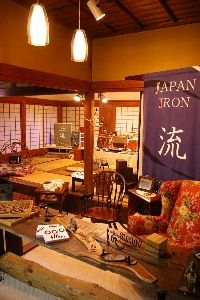
RYU STUDIO
There are various art works that we Japanese are proud of, and Nanbu Ironware is one of them.
Today, I’d like to introduce my acquaintance who creates new Nanbu iron works by bringing a traditional technique of Iwate Prefecture into art.
His name is Mr. Suzuki, and he is a designer of RYU STUDIO.
First of all, let me explain what Nanbu Iron is.
[NANBU IRON]
Recently, Nanbu Iron has increasingly gained an international appreciation in the fashion world in such places as New York City and Paris.
Today’s popularity of Nanbu Iron can be directly traced back to its roots 400 years ago.
During this time period, King Nanbu, the leader of the Nanbu people of North Eastern Japan, cherished the quality and strength of the Nanbu Iron while having a keen eye and deep appreciation for art; thus, under King Nanbu’s patronage the Nanbu Iron casting techniques and avenues of artistic expression flourished.
Today’s two particularly popular items that came out of this time period are the vine-shaped handled iron teapot and the decorative iron wind chime.
Both items are very beautiful to see and touch.
What makes the vine-shaped handled teapot significant is the brilliance of the casting techniques.
Previously, teapots were cast from a mold, but with improving techniques under King Nanbu’s leadership blacksmiths were able to create an artistic handle separate from the cast pot.
This vine-handle was hammered – not cast – into shape.
Hence, it is this hammering technique which RYU STUDIO uses in creating our uniquely beautiful and elegant jewelry.
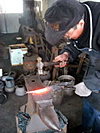 |
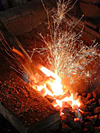 |
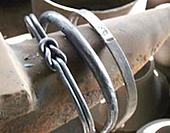 |
Mr. Suzuki creates the works that combined Nanbu Iron and Japanese lacquer “urushi”.
For your information, let me explain what urushi is.
[JAPANESE LACQUER – Urushi]
“Urushi” is natural paint and coating refined from Japanese poison ivy.
For 5500 years, the Japanese people have been using urushi as a decorative, finishing lacquer.
Throughout Japan’s long history, traditional urushi has been used in a variety of setting s to decorate, including religious places such as Shinto shrines; and within the military armor and weapons arena to decorate such items as swords, spears, helmets, and other armor; and, in prominent households such as the Emperor’s, local kings’, and the Samurais’ to decorate various dishware.
A few hundred years ago, when the first Europeans saw and used traditional urushi (they called it “JAPAN”), they immediately fell in love with the style and utility for the same reasons as the Japanese people have used and loved urushi for thousands of years – on both wood and iron.
The finishing shine creates a brilliant artistic impression, while creating a renowned strength on the product; in addition, the lacquer highlights the surface of the product in order to give the beholder of the product a personalized experience.
Now, let’s look at his works.
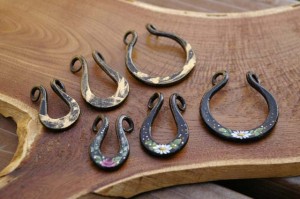 |
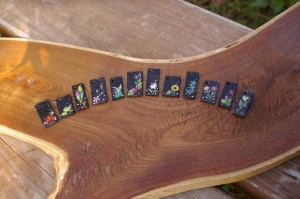 |
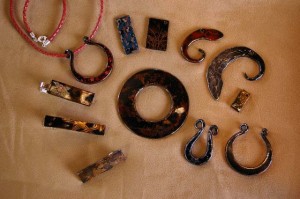 |
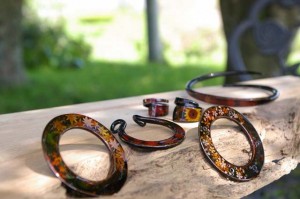 |
As you can see, a lot of Mr. Suzuki’s works are with horseshoe motifs.
With these iron works, he makes cell phone straps, key chains and pendants.
These are the finished works that are sold.
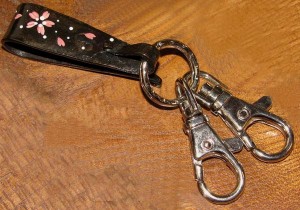 |
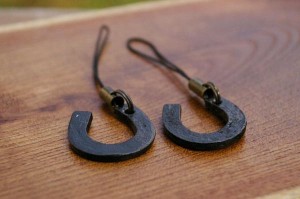 |
 The first strap that painted flowers is one of the birth flowers works.
The first strap that painted flowers is one of the birth flowers works.
From January to December, each month’s strap has its birth flower painted.
These works were all Nanbu Iron cast by craftsmen’s hands, and each painted work was sincerely painted by hand.
How do you like them?
I think the works combined horseshoes and urushi are rare, and hand made works are tasteful!
JAPAN Style will regularly introduce his works, so please look forward to the next post!
If you are interested in those items, please contact me from HERE!
This is JAPAN Style!
You should follow me on Twitter HERE.
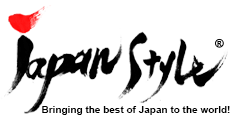



![[Photoblog] Japanese “HOKUSAI” Traditional Digital Print Tablecloth](http://www.japanstyle.info/wp-content/uploads/2012/10/hokusai-tablecloth_20121012-65x65.jpg)


![[Japan after Quake] New Program Opens! Private School to Promote Reconstruction of Fukushima](http://www.japanstyle.info/wp-content/uploads/2013/06/20130601_fukushima01-65x65.jpg)

Recent Comments